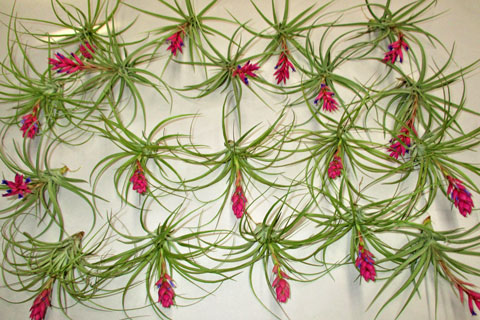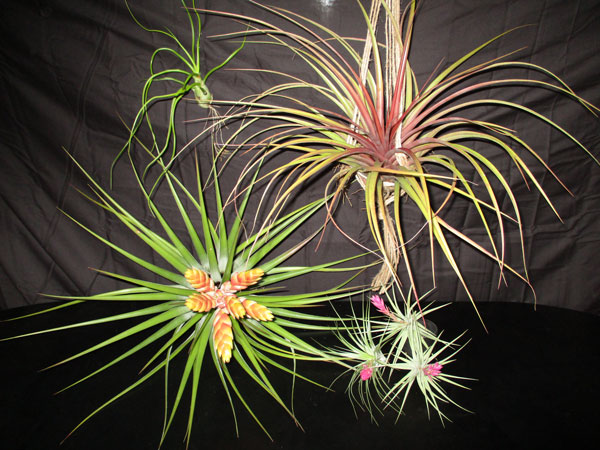1/1/2020
Behind the Variety: The Tillandsia Revival
Katie Elzer-Peters

Proving that everything old is new again, tillandsias are once again hot sellers in the houseplant world as quirky and low-maintenance plants for the designer, collector and first-time houseplant owner. This exotic no-soil plant, popular back in the 1970s in terrariums, has become the hipster of the houseplants in recent years, which is great news for independent garden centers. But, before they can get into the eager hands of buyers, they have to be carefully selected, trialed and multiplied. That’s where Russell’s Bromeliads comes in.
From the Wild to the Windowsill
During their first round of popularity (1970s), tillandsias were commonly collected from the wild in South America and hybridized. Today, tillandsias are still collected and hybridized, but with much more international oversight for long-term preservation of wild populations. They’re then offered for sale to places like Russell’s Bromeliads, which trials and selects the varieties that they think will be a good fit for the marketplace.
“There are a lot of hybrids that are odd and not aesthetically appealing,” says Michael Salvi of Russell’s. “Collectors like them because they’re different and rare. What we try to do is to separate out and increase the numbers of tillandsias that are interesting because of their shape, color, texture and flowering ability.”
The trialing process to nurture exceptionally interesting, sturdy bromeliads can take up to 10 years, Michael says. It took that long to develop the large tillandsia varieties that won the first place “Best New Plant Award” at the 2019 IGC Show: Yellow Star, Large Capitata Maroon and Tropiflora.
“Tillandsias can be very slow-growing,” he explains. “So it takes quite a long time to develop for those that have good color, the ability to produce a lot of pups and the ability to ship well.”
During trialing, Michael says that tillandsias that produce around 10 pups are promising, while those that put out only a couple of pups don’t make the cut because it would take too long to build up numbers to offer for retail. When a high producer is identified, then Russell’s runs shipping tests because they want to make sure the plants will stand up to shipping. “Some are more brittle than others,” he says.
Bromeliads: A Growing Business
Understanding the lifecycle of a tillandsia is key because tillandsias only produce pups after they bloom. Michael states, “Once we treat a tillandsia to encourage it to flower, it can take a couple of months for it to bloom and only then does it begin to make babies—and those babies take, on average, seven months to grow to maturity.”
Tillandsias’ ease of shipping makes them an attractive option for the independent garden center, as a full shipment can be mailed door-to-door in a couple of boxes—avoiding the necessity of filling an entire truck for an order. And after they arrive at the garden center, the marketing options are almost endless, from terrariums and fairy gardens to craft projects and easy display options. It’s these very characteristics that make tillandsias so irresistible to consumers and so easy for garden centers to market.
 “Even with a markup of two and a half to three times, the end price to the consumer makes them an ideal impulse purchase, particularly when displayed creatively to inspire simple DIY projects like terrariums,” Michael says.
“Even with a markup of two and a half to three times, the end price to the consumer makes them an ideal impulse purchase, particularly when displayed creatively to inspire simple DIY projects like terrariums,” Michael says.
Remaining Retail-Ready
Michael recommends merchandising tillandsias by providing the consumer with everything that’s needed to create displays of their own. Stocking loose plants along with a variety of glassware, sand, gravel, pots and moss turns a $4 plant into a $25 (or more) purchase.
He also encourages garden centers to create (or purchase) care cards to educate consumers on the particular care that tillandsias require. Although these plants are low-maintenance, their requirements are different enough from that of more typical and familiar houseplants, and increasing the growing confidence of the consumer always bodes well for future sales.
As far as revivals go, the tillandsia version is one with real staying power—any plant with this wide of a range of design options, DIY project ideas and collector possibilities isn’t going anywhere anytime soon. GP
Katie Elzer-Peters is a garden writer and owner of The Garden of Words, LLC, a marketing and PR firm handling mostly green-industry clients. Contact her at Katie@thegardenofwords.com.